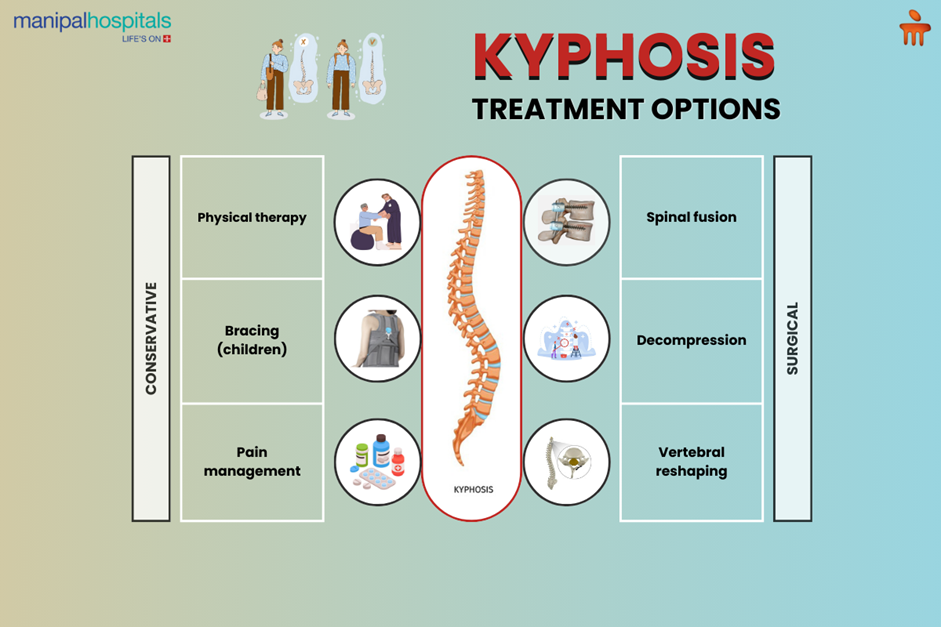
A hunched-forward upper back is the diagnostic sign of kyphosis. People of all ages may develop Kyphosis, but older adults experience it more often due to age-related breakdown. Several kyphosis conditions are mild, but medical intervention is essential for severe cases. Our experienced physiotherapists explain how timely identification of kyphosis with appropriate medical intervention leads to better patient quality of life and the prevention of future complications.
Synopsis
What Is Kyphosis and What Causes It?
Kyphosis develops due to either misalignment of the spinal bones or compression of the vertebrae. For industrial workers, job-related risks and ageing are key Poor Posture: Slouching and hunching positions impact the spine, mainly affecting office workers and teenage individuals.
-
Spinal Degeneration: Spinal deterioration due to natural aging processes occurs frequently among people of advanced age.
-
Osteoporosis: Weak bones become thin to the point where spine compression fractures occur.
-
Congenital Conditions: Spinal abnormal development exists since birth.
-
Scheuermann’s Disease: This developmental issue occurs in adolescents during their growth period, and spinal shapes undergo alteration.
-
Injury or Trauma: Spinal injuries, together with fractures, frequently cause improper spinal curvature.
Types of Kyphosis
Kyphosis can be classified into several types based on its causes, age of onset, and severity. Understanding the different types is important for determining the most appropriate treatment plan. The classification of kyphosis depends on its origin factors and intensity grade. Here are the common types:
-
Postural Kyphosis: The condition is generally mild with postural origins and weak muscles.
-
Scheuermann’s Kyphosis: Adolescent structural deformity results in abnormal wedge-shaped vertebrae instead of standard rectangular spinal shape.
-
Congenital Kyphosis: This condition appears at birth because of foetal spinal malformations.
-
Nutritional or Secondary Kyphosis: Linked to diseases like rickets or spinal infections.
-
Age-related Kyphosis: It arises from two degenerative disorders: osteoporosis and arthritis.
Common Symptoms and Warning Signs
Kyphosis symptoms can range from mild posture issues to severe pain and stiffness. Below are signs to watch for:
-
Visible Rounded Back: One of the most noticeable signs of kyphosis is a visible curve in the upper back, often described as a hump or rounded appearance.
-
Back Pain: Mild to severe pain, especially in the upper or mid-back, is common in people with kyphosis. The pain may worsen with prolonged sitting or standing.
-
Stiffness: Limited mobility in the spine, especially when trying to straighten the back or bend forward.
-
Fatigue: Muscle fatigue, especially in the back and shoulders, is caused by the effort required to maintain an upright posture.
-
Difficulty Breathing: In severe cases, the spinal curvature may affect lung capacity, leading to shortness of breath or difficulty breathing deeply.
-
Neck and Shoulder Pain: Kyphosis can lead to a misalignment of the neck and shoulders, causing discomfort or tension in these areas.
Consult our physiotherapy department in Manipal Hospital, Hebbal, Bangalore, for expert care and treatment.
Can Kyphosis Be Reversed Without Surgery?

Managing kyphosis non-surgically involves a combination of therapy, exercise, and consistent postural awareness. Here are the most effective non-surgical approaches:
-
Physical Therapy: A structured therapy program helps strengthen the spinal muscles and improve spinal alignment over time.
-
Posture Correction Exercises: Targeted exercises, such as chin tucks, wall angels, and scapular squeezes, retrain your body to hold a straighter posture.
-
Bracing (for Adolescents): In growing children and teens, a spinal brace can halt progression and, in some cases, improve spinal curvature.
-
Yoga and Pilates: These low-impact practices enhance flexibility, balance, and core strength, all supporting spinal health.
-
Pain Management: Non-surgical methods like heat therapy, massage, or over-the-counter pain relievers help manage the discomfort linked to kyphosis.
-
Lifestyle Modifications: Ergonomic workstations, avoiding prolonged slouching, and regular movement throughout the day reduce strain on the spine.
More Reads: Slipped Disc-Symptoms, Treatments, Recovery
Conclusion
Physical therapy and better daily habits can improve mild postural forms, while more severe types may require medical or surgical care. Staying informed and seeking timely help are key to preventing complications and living comfortably with kyphosis.
FAQ's
Mild postural Kyphosis can improve with physical therapy and posture correction. Structural types may need medical treatment.
Not always, but many people experience back pain, stiffness, or muscle fatigue over time.
It can appear in adolescence (Scheuermann’s) or later in life due to age-related changes.
Only in severe cases with significant pain, deformity, or nerve compression.
Incorrect exercises can. Always follow a professional's guidance for safe, effective results.





















 4 Min Read
4 Min Read


.png)










